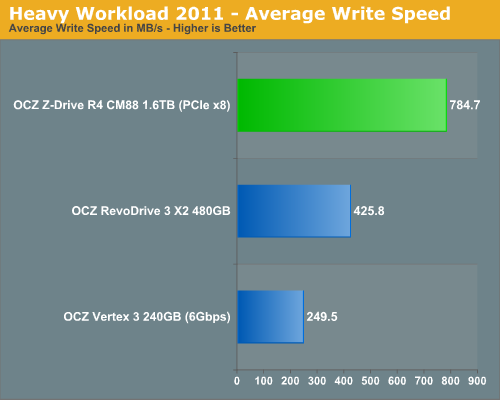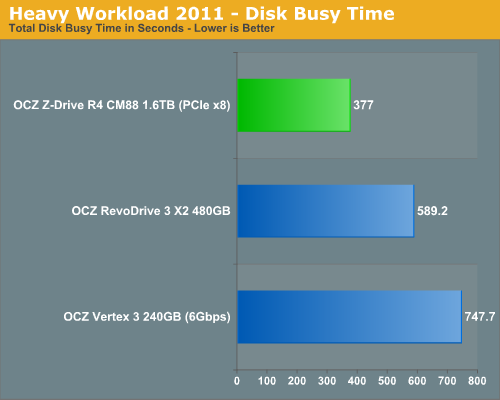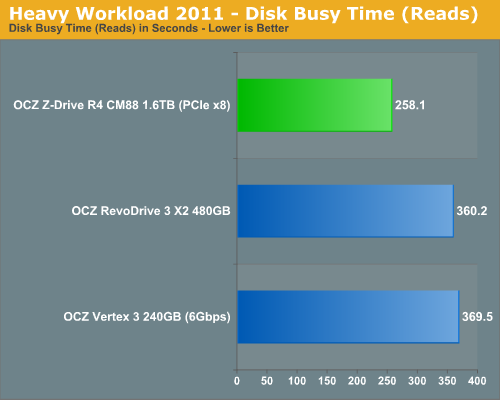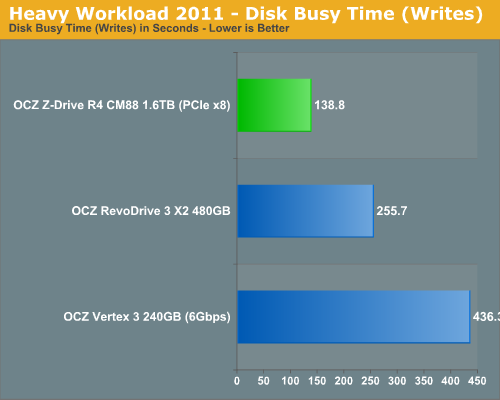OCZ Z-Drive R4 CM88 (1.6TB PCIe SSD) Review
by Anand Lal Shimpi on September 27, 2011 2:02 PM EST- Posted in
- Storage
- SSDs
- OCZ
- Z-Drive R4
- PCIe SSD
AnandTech Storage Bench 2011
Last year we introduced our AnandTech Storage Bench, a suite of benchmarks that took traces of real OS/application usage and played them back in a repeatable manner. I assembled the traces myself out of frustration with the majority of what we have today in terms of SSD benchmarks.
Although the AnandTech Storage Bench tests did a good job of characterizing SSD performance, they weren't stressful enough. All of the tests performed less than 10GB of reads/writes and typically involved only 4GB of writes specifically. That's not even enough exceed the spare area on most SSDs. Most canned SSD benchmarks don't even come close to writing a single gigabyte of data, but that doesn't mean that simply writing 4GB is acceptable.
Originally I kept the benchmarks short enough that they wouldn't be a burden to run (~30 minutes) but long enough that they were representative of what a power user might do with their system.
Not too long ago I tweeted that I had created what I referred to as the Mother of All SSD Benchmarks (MOASB). Rather than only writing 4GB of data to the drive, this benchmark writes 106.32GB. It's the load you'd put on a drive after nearly two weeks of constant usage. And it takes a *long* time to run.
1) The MOASB, officially called AnandTech Storage Bench 2011 - Heavy Workload, mainly focuses on the times when your I/O activity is the highest. There is a lot of downloading and application installing that happens during the course of this test. My thinking was that it's during application installs, file copies, downloading and multitasking with all of this that you can really notice performance differences between drives.
2) I tried to cover as many bases as possible with the software I incorporated into this test. There's a lot of photo editing in Photoshop, HTML editing in Dreamweaver, web browsing, game playing/level loading (Starcraft II & WoW are both a part of the test) as well as general use stuff (application installing, virus scanning). I included a large amount of email downloading, document creation and editing as well. To top it all off I even use Visual Studio 2008 to build Chromium during the test.
The test has 2,168,893 read operations and 1,783,447 write operations. The IO breakdown is as follows:
| AnandTech Storage Bench 2011 - Heavy Workload IO Breakdown | ||||
| IO Size | % of Total | |||
| 4KB | 28% | |||
| 16KB | 10% | |||
| 32KB | 10% | |||
| 64KB | 4% | |||
Only 42% of all operations are sequential, the rest range from pseudo to fully random (with most falling in the pseudo-random category). Average queue depth is 4.625 IOs, with 59% of operations taking place in an IO queue of 1.
Many of you have asked for a better way to really characterize performance. Simply looking at IOPS doesn't really say much. As a result I'm going to be presenting Storage Bench 2011 data in a slightly different way. We'll have performance represented as Average MB/s, with higher numbers being better. At the same time I'll be reporting how long the SSD was busy while running this test. These disk busy graphs will show you exactly how much time was shaved off by using a faster drive vs. a slower one during the course of this test. Finally, I will also break out performance into reads, writes and combined. The reason I do this is to help balance out the fact that this test is unusually write intensive, which can often hide the benefits of a drive with good read performance.
There's also a new light workload for 2011. This is a far more reasonable, typical every day use case benchmark. Lots of web browsing, photo editing (but with a greater focus on photo consumption), video playback as well as some application installs and gaming. This test isn't nearly as write intensive as the MOASB but it's still multiple times more write intensive than what we were running last year.
As always I don't believe that these two benchmarks alone are enough to characterize the performance of a drive, but hopefully along with the rest of our tests they will help provide a better idea.
The testbed for Storage Bench 2011 has changed as well. We're now using a Sandy Bridge platform with full 6Gbps support for these tests. All of the older tests are still run on our X58 platform.
AnandTech Storage Bench 2011 - Heavy Workload
We'll start out by looking at average data rate throughout our new heavy workload test:

I don't expect many desktop/workstation users to buy Z-Drive R4s, but this is the fastest SSD we've tested in our AnandTech Storage Bench 2011 suite. Note the imperfect scaling from 4 to 8 controllers however, the increase over the RevoDrive 3 X2 is only 56%. Even with a strenuous desktop workload it's tough to fully load all 8 controllers in the Z-Drive R4.


The next three charts just represent the same data, but in a different manner. Instead of looking at average data rate, we're looking at how long the disk was busy for during this entire test. Note that disk busy time excludes any and all idles, this is just how long the SSD was busy doing something:













57 Comments
View All Comments
caliche - Wednesday, September 28, 2011 - link
I am sure he is referring to the previous versions of the z-drive, which is all you can use as an indicator.I am an enterprise customer. Dell R710s and two Z-Drive R2 M84 512GB models, one in each. I have had to RMA one of them once, and the other is on it's second RMA. They are super fast when they work, but three failures across two devices in less than a year is not production ready. We are using them in benchmarking servers running Red Hat Enterprise 5 for database stores, mostly read only to break other pieces of software talking to it. Very low writes.
But here is the thing. When they power on, one or more of the four RAID pieces is "gone". This is just the on board software on the SSD board itself, no OS, no I/O on it at all besides the power up RAID confidence check. Power on the server, works one day, next day the controller on the card says a piece is missing. That's not acceptable when you are trying to get things done.
In a perfect world, you have redundant and distributed everything with spare capacity and this is not a factor. But then you start looking at dealing with these failures and you start to ask yourself is your time better spent on screwing around with an RMA process and rebuilds or optimizing your environment?
ypsylon - Thursday, September 29, 2011 - link
Nobody in the right frame of mind using SSD in enterprise segment (not even interested in them as consumer drives, but that is not the issue here). SSDs are just as unreliable as normal HDDs with ridiculous price point. You can lose all of data much quicker than from normal HDD. RAID arrays built from standard HDDs are just as fast as 1 or 2 "uber" SSDs and cost fraction of a SSD setup (often even including cost of the RAID controller itself). Also nobody running large arrays in RAID0 (except maybe video processing). RAID0 is pretty much non-existent in serious storage applications. As a backup I much more prefer another HDD array than unreliable, impossible to test, super-duper expensive SSD.You can't tests NAND reliability. That is the biggest problem of SSDs in business class environment. Because of that SSD will whiter and die in the next 5-10 years. SSDs are not good enough for industry, if you can't hold on to big storage market then no matter how good something is, it will die. Huge, corporate customers are key to stay alive is storage market.
Zan Lynx - Thursday, September 29, 2011 - link
You are so, so wrong.Enterprises are loving SSDs and are buying piles of them.
SSDs are the best thing since sliced bread if you run a database server.
For one thing, the minimum latency of a PCIe SSD 4K read is almost 1,000 times less than a 4K read off a 15K SAS drive. The drive arrays don't even start to close the performance gap until well over 100 drives, and even then the drive array cannot match the minimum latency. It can only match the performance in parallel operations.
If you have a lot of operations that work at queue depth of 1, the SSD will win every time, no matter how large the disk array.
leonzio666 - Wednesday, November 2, 2011 - link
Bear in mind though, that enterprises (real heavy weights) probably preffer something like fusion-io io-drives which btw are the only ssd`s running in IBM driven blade servers. With speeds up to 3 Gb/s and over 320 k IOPS it`s not surprising they cost ca 20k $$ per unit :D So it`s not true that SSD`s in general are not good for the enterprise segment. Also, and this is hot - these ssd use SLC NAND...MCS7 - Thursday, September 29, 2011 - link
I remember Anand doing a VOODOO 2 card review (VIDEO) way way way back at the turn of the millenium! Oh boy..we are getting OLD....lol take care allGooger - Thursday, September 29, 2011 - link
Statistics for CPU usage would have been handy as some storage devices have greater demands for the CPU than others. Even between various HDD makes, CPU use varies.alpha754293 - Thursday, September 29, 2011 - link
Were you able to reproduce the SF-2xxxx BSOD issue with this? or is it limited to just the SF-2281?